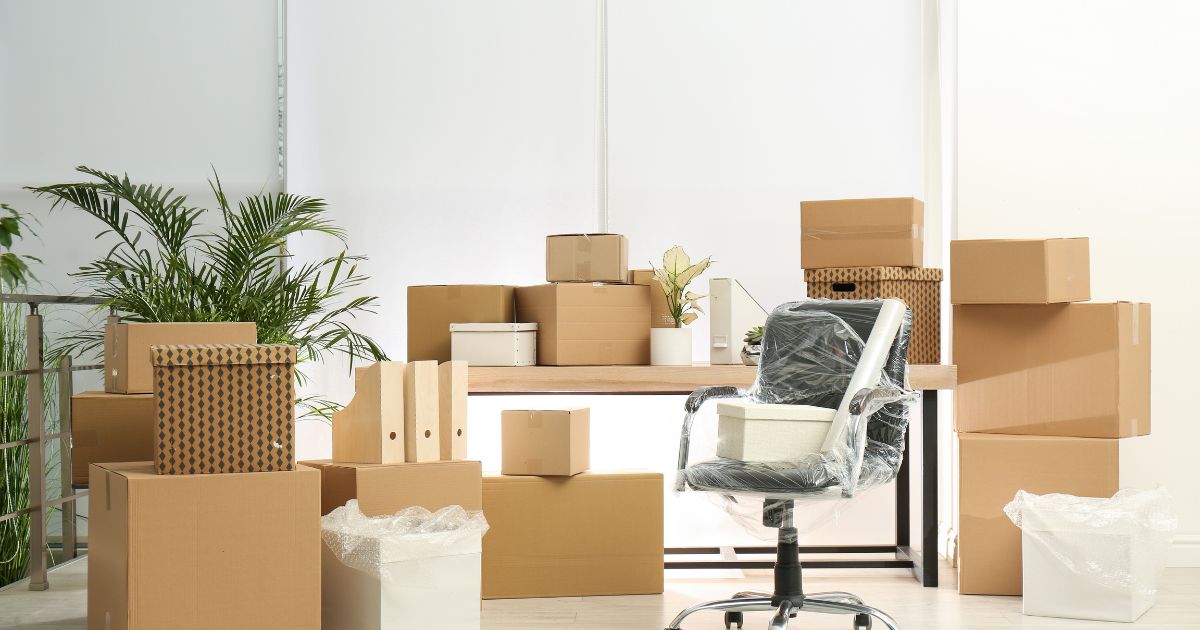
Moving office equipment is stressful enough without the added worry of damaged computers, printers, or monitors during transport. Your fragile equipment requires special care to ensure it arrives safely at your new location, ready for action.
Proper packing and planning are key to a smooth office move. At Don Farr Moving & Storage, we’ve helped countless businesses relocate with minimal disruption, and we’re here to share our expert tips for keeping your delicate equipment secure throughout the process.
This guide explains the importance of proper packing techniques and provides practical, step-by-step instructions for safeguarding your valuable office equipment during the move. By following these tips and using the right materials, you can significantly reduce the stress of the move and ensure a successful transition to your new space.
The Importance of Proper Packing for Delicate Office Equipment
Imagine arriving at your new office, eager to set up your workspace, only to discover that your computer monitor is cracked or your printer is jammed with loose toner. Improper packing can damage equipment, resulting in costly replacements, extended downtime, and lost productivity. The time and money spent on repairs can quickly add up, damaging your move and budget.
On the other hand, taking the time to pack your delicate office equipment correctly can make all the difference. You can minimize the risk of damage during transport by using high-quality materials and proven techniques. This not only saves you from the headache of dealing with broken equipment but also reduces the overall stress of the move. Plus, when your equipment arrives in perfect condition, you can return to work faster, ensuring a seamless transition for your business.
Proper packing materials are crucial for safely transporting your delicate office equipment. Sturdy, corrugated boxes provide a solid foundation, while bubble wrap and packing peanuts offer the cushioning needed to absorb shocks and vibrations during the move. Remember to label each box clearly, indicating its contents and any special handling instructions. This will make the unpacking process much more efficient and help you quickly identify items requiring extra care.
The 7 Tips for Safe Transport of Delicate Office Equipment
Now that we’ve discussed the importance of proper packing, let’s discuss the specifics. Follow these seven tips to ensure your delicate office equipment arrives at your new location in pristine condition.
Tip 1: Gather the Right Packing Materials
Before you start packing, ensure you have all the necessary supplies. Here’s a list of essential packing materials you’ll need:
Sturdy, corrugated boxes in various sizes
- Bubble wrap
- Packing peanuts
- Packing paper
- Packing tape
- Labels and markers
- Scissors or box cutter
- Furniture blankets or moving pads
- Stretch wrap for securing moving blankets
- Sturdy pallets for larger equipment (e.g., servers)
Invest in high-quality materials to protect your delicate office equipment. Don’t be tempted to cut corners by using old, flimsy boxes or insufficient cushioning. Your equipment is valuable and deserves the best care during the move.
Tip 2: Utilize Original Packaging Whenever Possible
The original packaging is often your best bet when packing your office equipment. Here’s why:
- Custom-fit: Original packaging is designed specifically for your equipment, ensuring a perfect fit and optimal protection.
- Protective inserts: Many original packages include custom-shaped foam inserts or molded plastic pieces that cradle your equipment securely.
- Instructions: Original packaging may come with the manufacturer’s instructions for safe packing and handling.
If you have the original boxes and packaging materials for your computers, monitors, printers, or other equipment, set them aside during the move. If you don’t have the original packaging, don’t worry. You can still ensure your equipment’s safety by following these steps:
- Choose sturdy, corrugated boxes slightly larger than your equipment, allowing room for cushioning materials.
- Create a protective base by filling the bottom of the box with bubble wrap or packing peanuts.
- Wrap your equipment carefully in bubble wrap, securing it with packing tape.
- Place the wrapped item in the box and fill any empty spaces with additional cushioning materials.
- Close and seal the box with packing tape, labeling it clearly with the contents and any special handling instructions.
By utilizing original packaging whenever possible and following these steps when unavailable, you’ll be well on your way to a successful and stress-free office move.
Tip 3: Pack Each Piece Individually with Care
Each type requires specific packing techniques for delicate office equipment to ensure its safety during the move. Here’s how to handle everyday items:
Computers and Laptops:
- Use original packaging if available, or choose a sturdy box with enough space for cushioning.
- Wrap the device in bubble wrap or an anti-static bag, then place it in the box with packing peanuts or air pillows for added protection.
- Label the box as “Fragile – Computer” or “Fragile – Laptop.”
Monitors and Screens:
- Use original packaging if available, or find a box slightly larger than the monitor.
- Wrap the monitor in bubble wrap, ensuring all sides are covered and the screen is protected.
- Place the wrapped monitor in the box with packing peanuts or air pillows for cushioning.
- Label the box as “Fragile – Monitor” or “Fragile – Screen.”
Printers, Scanners, and Copiers:
- Remove ink or toner cartridges and pack them separately in sealed plastic bags.
- Remove paper trays and other detachable components, wrapping them individually in bubble wrap.
- Wrap the main unit in bubble wrap or packing blankets, securing it with packing tape.
- Place the wrapped unit in a sturdy box with ample cushioning.
- Label the box as “Fragile – Printer,” “Fragile – Scanner,” or “Fragile – Copier.”
Other Equipment (Projectors, Telephone Systems, Network Equipment):
- Follow the manufacturer’s instructions for packing if available.
- Remove any detachable parts and pack them separately.
- Wrap the main unit securely in bubble wrap or packing blankets.
- Place the wrapped unit in a sturdy box with cushioning on all sides.
- Label the box clearly with the contents and “Fragile.”
Peripherals (Keyboards, Mice, External Hard Drives):
- Wrap each item individually in bubble wrap.
- Pack them securely in the same box as the primary device or in separate, labeled boxes with cushioning.
Use appropriate packing materials, secure boxes with packing tape, and label each box clearly with its contents and “Fragile” to ensure careful handling during the move.
Tip 4: Backup Your Data and Prepare Your Electronics
Before packing your computers, servers, and other data storage devices, it’s crucial to back up your important files and data. This ensures that even if something goes wrong during the move, your valuable information will be safe and accessible. Consider using cloud storage, external hard drives, or USB flash drives to create multiple backups.
Once your data is secure, prepare your electronics for the move:
- Unplug all cables and power cords, labeling them for easy reassembly at your new location.
- Remove ink or toner cartridges from printers to prevent leaks and pack them separately.
- Use snap-lock bags to keep small parts like screws or cables together and labeled.
Tip 5: Disassemble Large Equipment When Possible
For larger office equipment like conference tables, desks, or shelving units, disassembly can make the moving process safer and more manageable. Follow these steps:
- Consult the manufacturer’s instructions or look for online guides on disassembling each item correctly.
- Use the correct tools and keep track of all screws, bolts, and small parts, placing them in labeled bags.
- Wrap each disassembled component in moving blankets or bubble wrap for protection.
- Label each wrapped component clearly to know which parts go together during reassembly.
Tip 6: Label Everything Clearly and Create an Inventory
Proper labeling is essential for a smooth and organized office move. As you pack each box, clearly label it with the following information:
- Contents (e.g., “Printer,” “Monitors,” “Keyboards”)
- Fragile items
- Room or department destination
- Box number (e.g., “1 of 3,” “2 of 3,” etc.)
In addition to labeling your boxes, create a detailed inventory list that includes:
- Box numbers and contents
- Condition of items before the move
- Destination room or department
This inventory will help you keep track of your office equipment during the move and ensure that everything arrives at your new location as expected.
Tip 7: Load and Transport with Care
When loading your office equipment onto the moving truck, remember to:
- Place heavier items on the bottom and lighter, more fragile items on top.
- Secure boxes and equipment to prevent shifting during transport.
- Use furniture, blankets, or moving pads to protect items from scratches and dings.
- Keep your most valuable and sensitive equipment with you during the move.
By following these tips and taking the time to properly pack, label, and load your delicate office equipment, you’ll be well-prepared for a successful and stress-free move.
Conclusion
Moving your office can be daunting, especially when it comes to ensuring the safety of your delicate equipment. However, by following these seven tips and investing in proper packing materials, you can minimize the risk of damage and set yourself up for a successful move.
Careful planning and attention to detail are the keys to a stress-free office relocation. By adequately packing each piece of equipment, labeling your boxes clearly, and creating a detailed inventory, you’ll be able to track your items throughout the move and ensure that everything arrives at your new location in perfect condition.
If you’re overwhelmed by the prospect of moving your office, know you don’t have to go it alone. At Don Farr Moving & Storage, we have the expertise and equipment to handle even the most delicate items, ensuring your office move succeeds. Need help? Contact us today!


